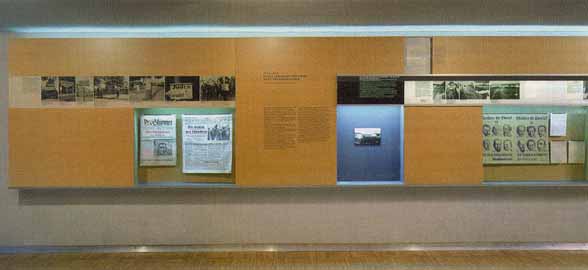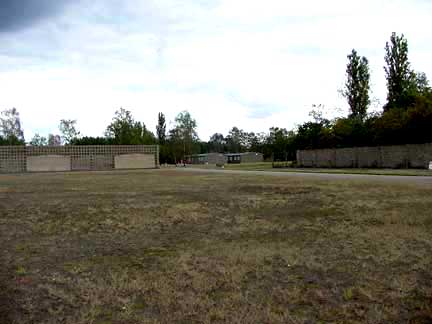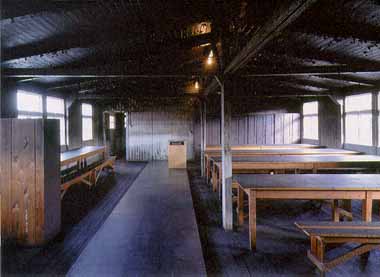Jewish Museum at Sachsenhausen When the "association of foreign prisoners" initiated a plan to build a Memorial Site on the grounds of the former concentration camp at Sachsenhausen, they commissioned a new museum to be created, which was to be called the Museum for Anti-fascist Resistance Fighters of the European People. The museum was to have 19 sections arranged by country with the Soviet Union and Germany each receiving twice as much exhibition space, according to a pamphlet entitled "From the Memory to the Monument," available at the camp bookstore. The museum was primarily focused on World War II and the resistance against Nazi Germany and represented "the ideology of the German Socialist Unity Party (SED)." There was no place in the Sachsenhausen museum for the genocide of the Jews, nor for the genocide of the Sinti and Roma. The pamphlet continues, "Only after protests came from the 'Union of Antifascist Resistance Fighters in Israel" did the East German government, shortly before the opening of the memorial, establish the Museum for the Resistance Struggle and the Suffering of Jewish Citizens. It was installed in the reconstructed 'Jewish' barracks 38 and 39, located in the area of the small camp. Visitors received minimal information about the particular situation of the Jewish prisoners in Sachsenhausen. The exhibition did not tell of the number of Jews imprisoned in Sachsenhausen, nor of the particular persecution they were subjected to. Sinti and Roma, homosexuals and other non-political prisoner groups were not mentioned (which was the case in most West Germany memorials as well)." After the Jewish protest, the two former Jewish barracks, blocks 38 and 39, were reconstructed in 1961 on the spot where they had formerly stood in the area called the "Small Camp." This was the camp that was set up to the right of the gate house in 1938 when 6,000 Jews were sent to Sachsenhausen after a total of 30,000 Jewish men were rounded up on November 9 and 10, 1938 "in order to protect them from the wrath of the German people," according to Rudolf Höss who was an adjutant at the camp. This action occurred during the pogrom known as Kristallnacht (Crystal Night) because the glass was broken in all the Jewish shop windows. The Jews were held in "protective custody" until their families could arrange visas for them to leave Germany. The last of the Jews in Sachsenhausen were deported to the Auschwitz-Birkenau camp in Poland in October 1942. The Jewish museum brochure notes that "Between 1942 and 1945 the National Socialists perpetrated the genocide of European Jews. During this time there were only few Jewish prisoners left in Sachsenhausen."  When I first entered the Jewish museum, I detected the subtle, lingering odor of charred wood. Then I remembered reading in the newspaper about the arson fire perpetrated by neo-Nazis. It was in September 1992, a few days after Israeli Prime Minister Jitzhak Rabin had visited the Sachsenhausen Memorial, that the reconstructed barracks were severely damaged and partly destroyed by a fire that was attributed to "right wing extremists."   According to information presented at the Barrack 38 Museum, the barrack blocks 37, 38 and 39, were the first addition to the original camp and were completed in the summer of 1938. At first, they were used to segregate the Sinti and Roma prisoners. Later these three blocks became known as the Jewish barracks and the whole area was called the Small Camp. According to Rudolf Höss, there were virtually no Jews in Sachsenhausen before 1938. Most of the prisoners were "greens" or criminals who wore the green triangle. He wrote that the Greens "welcomed the Jews with great pleasure as objects of exploitation. We had to take their money away from them, otherwise there would have been chaos in the camp." Höss, who was later promoted to Commandant of Auschwitz where he was responsible for gassing millions of Jews, claimed that he "never hated the Jews." Regarding the behavior of the Jews at Sachsenhausen, Höss wrote, "The Jews did damage to each other whenever they could. Each tried to get an easy job for himself. In fact, with the tacit approval of the Kapos, whom they had bribed, new jobs were constantly being invented to avoid real work. In order to get a nice easy job they did not shrink from getting rid of their fellow prisoners by making false accusations against them. When they had achieved a certain position, they mercilessly bossed and tormented members of their own race in a beastly manner. They far surpassed the Greens in every way. In order to escape this torment and often out of desperation, many Jews threw themselves into the electrified barbed wire or attempted to escape with the hope of being shot. Some just hanged themselves. The Kommandant reported these continuous occurrences to Eicke (head of all the concentration camps). He replied, 'Just let them be. Let the Jews devour each other without interference.' " Beginning in February 1942, all the German Jews were transported to the east to camps in Poland and White Russia as the "Final Solution to the Jewish Question" was put into action. By October 1942, the Jews at Sachsenhausen had been deported to the Auschwitz-Birkenau camp in Poland. After that, these barracks were used for political prisoners from Poland and other countries. In the Spring of 1945, just before Sachsenhausen was liberated, the Small Camp was used for women prisoners. In 1961, barracks 38 and 39 were reconstructed, using original materials, and barrack 38 became the Museum of the Resistance and Suffering of Jewish Citizens. Inside you can see what the interior of the barracks looked like when it was living quarters for the Jewish prisoners. The ceilings have several layers of peeling paint with the top layer a dark brown color. The washroom is shown with two fountains set in the middle of two large round basins where the prisoners washed in a continuous supply of running water. On the floor is a series of small basins where the prisoners washed their feet. A poster on the wall said that the SS guards drowned some of the prisoners in the foot basin. There is also a broom closet where the SS would put prisoners for punishment and sometimes kill them, according to the museum. The barracks were furnished with flush toilets which are reddish brown in color.   The picture below, which is from a brochure
about the Jewish Museum, shows the tables where the Jewish prisoners
ate. This is the first time that I have I ever seen a display
of the tables in a concentration camp barracks; usually it is
only the bunk beds that are shown in the reconstructions at the
camp memorial sites.  According to the Museum brochure, "In 1992, shortly after the Israeli prime minister Yitzhak Rabin paid a visit, Wing B of barrack 38 was destroyed in an arson attack, while the other wing and barrack 39 were severely damaged. The attack was one of a series of extreme right wing xenophobic and anti-Semitic assaults perpetrated in Germany from 1992 onwards. In 1997, five years after the attack, reconstruction has been completed. The 'Barrack 38' Museum was designed and realized by the Frankfurt architects, Braun, Voigt & Partner. Its exterior conforms to the basic barrack design, whereas the interior has been expanded to suit museum purposes and now includes a basement level. Sky lights allow for some daylight to reach the new, lower level. Traces of the arson attack are preserved behind glass, thus forming part of the exhibition while simultaneously providing a bridging element to the old, restored part of the barrack." The Museum is exceptionally well designed; it is the work of Stuttgart architect, Professor H. G. Marz. The exhibits are arranged in four chronological segments, which document the story of the Jews in Sachsenhausen between 1936 and 1945 through 74 biographical accounts. The museum is in two tiers with the basement level devoted to the war years and the Nazi escalation of the persecution of the Jews. One of the persons featured is Herschel Grynszpan, a 17 year old youth who escaped to Paris during the early persecution of the Jews in Germany. His family was deported back to Poland in October 1938 along with thousands of Polish Jews who were not German citizens. The Polish government would only accept 10,000 of them and the rest had to live for months in a camp on the border between Poland and Germany until their fate could be decided. When Herschel received a letter from his sister about the miserable conditions in the camp, he decided to murder Ernst vom Rath, a Nazi official in the German Embassy in Paris to draw world attention to the plight of the refugees, since no other country had offered to take them. When vom Rath died three days after he was shot, a pogrom ensued in which 91 Jews were killed and virtually every Jewish shop and synagogue was damaged. The museum display notes that Herschel was never put on trial, and after the war his family declared him officially dead because he had disappeared. Another famous person mentioned in the museum display is Kurt Eisner Jr. , the son of the Communist revolutionary Kurt Eisner, who is described as "the Minister of Bavaria." Kurt Jr. was one of the political prisoners in Sachsenhausen. The museum display does not mention that Eisner Sr. was not elected to his post, but became the Minister after he led a revolution on November 7, 1918 in which the Communists took over the government of Bavaria, and forced Ludwig III of the centuries old House of Wittelsbach to flee for his life. Historian John Toland credits the revolutionary activity of Eisner as contributing to Hitler's hatred of the Jews. He wrote in his book, Adolf Hitler: "His simmering hatred of Jews had been activated by what he himself had witnessed on the streets of Munich. Everywhere Jews in power: first Eisner, then anarchists like Toller, and finally Russian Reds like Levine. In Berlin it had been Rosa Luxembourg; in Budapest Bela Kun, in Moscow Trotsky, Zinoviev and Kamenev. The conspiracy Hitler had previously suspected was turning into reality." One of the displays tells about the Nazi plot to fabricate an excuse to invade Poland. According to the museum, several prisoners from Sachsenhausen were dressed up like Polish soldiers, then shot and their bodies placed at a radio tower where the Nazis alleged that they had attacked the tower. I had previously heard this same story, but the fake Polish soldiers were prisoners taken from Dachau. (Steven Spielberg said in an interview that the Polish uniforms were obtained for the Nazis by none other than Oskar Schindler.) Nothing is mentioned in the museum about the atrocities in Poland when thousands of ethnic Germans were murdered by the Poles prior to the German invasion. The picture below shows the displays on the lower level of the museum which is reached by a glass elevator, or stairs if you prefer. The first thing you see as the elevator descends is two large movie screens at each end of a display. Huge photographs are flashed on the screen, changing every few seconds. In the picture below, which is in the museum brochure, you can see the famous (and controversial) picture of a soldier with a rifle aimed point blank at a mother holding a small child.  Gypsy MuseumCamp MuseumsTable of ContentsHome |